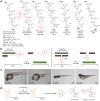Synthetic strategies for studying embryonic development
- PMID: 20609409
- PMCID: PMC2902240
- DOI: 10.1016/j.chembiol.2010.04.013
Synthetic strategies for studying embryonic development
Abstract
Developmental biology has evolved from a descriptive science to one based on genetic principles and molecular mechanisms. Although molecular biology and genetic technologies have been the primary drivers of this transformation, synthetic strategies have been increasingly utilized to interrogate the mechanisms of embryonic patterning with spatial and temporal precision. In this review, we survey how chemical tools and engineered proteins have been used to perturb developmental processes at the DNA, RNA, protein, and cellular levels. We discuss the design principles, experimental capabilities, and limitations of each method, as well as future challenges for the chemical and developmental biology communities.
Figures




References
-
- Airan RD, Thompson KR, Fenno LE, Bernstein H, Deisseroth K. Temporally precise in vivo control of intracellular signalling. Nature. 2009;458:1025–1029. - PubMed
-
- Ando H, Furuta T, Tsien RY, Okamoto H. Photo-mediated gene activation using caged RNA/DNA in zebrafish embryos. Nat Genet. 2001;28:317–325. - PubMed
Publication types
MeSH terms
Substances
Grants and funding
LinkOut - more resources
Full Text Sources
Other Literature Sources

